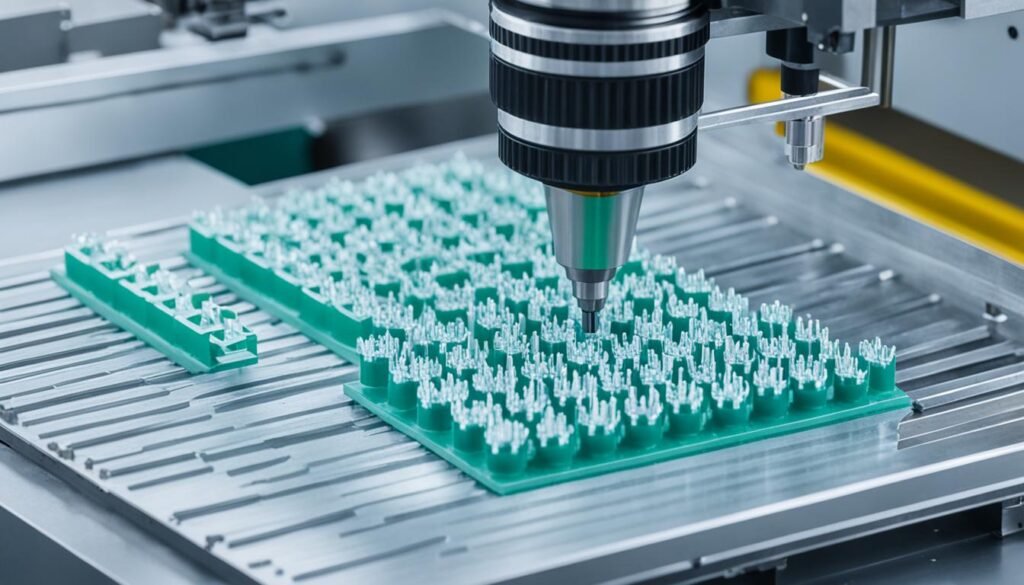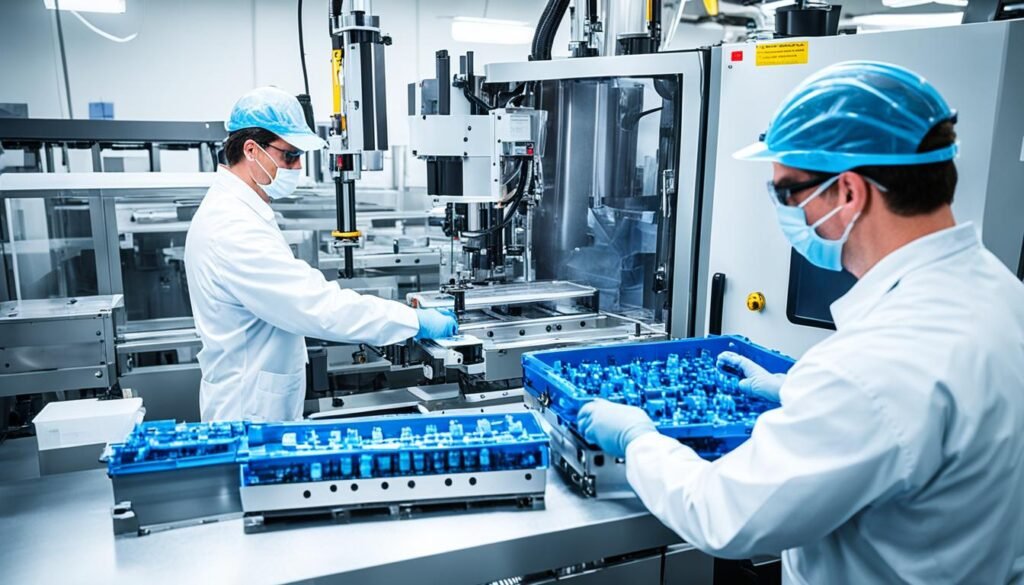Are you ready to dive into the complex world of THY Precision Injection Molding Optical Lenses process step by step for making advanced optical lenses? The need for smaller, more complex devices is growing fast. This means we must use advanced micro Injection Molding Optical Lenses techniques. But, what challenges will you face, and how can you make sure your process is precise and high-quality?
Key Takeaways
- Understand the injection moulding process step by step and its role in micro-molding optical components
- Explore the design and material considerations for precision micro-molding
- Discover the specialized equipment and techniques required for Injection Molding Optical Lenses success
- Learn how strategic partnerships can enhance your micro-molding capabilities
- Uncover the latest advancements in automated assembly and specialized packaging for micro-optics
Introduction to Injection Molding Optical Lenses step by step
At THY Precision, we dive deep into the Injection Molding Optical Lenses process step by step. This method is key in plastic manufacturing. It involves many steps, from preparing materials to ejecting the part, making high-quality plastic parts.
The Injection Molding Optical Lenses process starts with putting plastic pellets into a hopper. They get heated and turned into a liquid. Then, this liquid plastic is pushed into a mold, taking the shape it’s meant to have.
After cooling and solidifying, the mold opens, and out comes the finished product. It’s now ready for more work or to be put together with other parts.
Micro-molding is a special part of Injection Molding Optical Lenses. At THY Precision, our advanced machines can work with tiny amounts of plastic. They make parts with details as small as 50 to 5 microns. This is important for making small parts that are precise.
| Injection Molding Optical LensesProcess Step | Description |
|---|---|
| Material Preparation | Plastic pellets are fed into a hopper, where they are heated and melted into a liquid form. |
| Mold Filling | The molten plastic is injected into a pre-designed mold cavity, where it takes on the desired shape. |
| Cooling | The plastic part is allowed to cool and solidify within the mold. |
| Part Ejection | Once the part has cooled, the mold opens, and the finished product is ejected, ready for further processing or assembly. |
THY Precision is an expert in the Injection Molding Optical Lenses process, including micro-molding. We make precise plastic parts for modern manufacturing needs. Our knowledge of this technology helps our clients innovate and reach their goals.
Precision and Challenges in Micro Injection Molding Optical Lenses
At THY Precision, we know how tough it is to make micro-optic parts. Making tiny lenses and other optical items needs a high level of precision. This requires special knowledge and skills in micro molding.
Choosing the right mold design and plastic material is key to making these delicate parts. It’s important to understand the challenges of the Injection Molding Optical Lenses process to get the details right.
Injection Molding Optical Lenses – Design and Material Considerations
One big challenge in micro molding optics is making sure the mold fits together perfectly. The small size of the parts can cause problems with the flow of plastic. The feed system can be much bigger than the parts themselves.
- Precise mold cavity and core alignment to minimize parting line defects
- Careful gating and runner design to accommodate the small part size
- Optimization of the feed system to ensure efficient material flow and minimize waste
Choosing the right plastic for micro-optic parts is also vital. We look at things like how clear it is, how stable it is, and how it handles heat. These things affect how well the part works.
| Material Property | Importance in Micro-Optic Molding |
|---|---|
| Optical Clarity | Ensures high light transmission and minimizes distortion |
| Dimensional Stability | Maintains tight tolerances and preserves optical performance |
| Thermal Properties | Enables successful demolding and mitigates warpage or distortion |
At THY Precision, our experts are great at the Injection Molding Optical Lenses process, designing molds, picking materials, and fixing problems. We use our deep knowledge, top-notch equipment, and advanced methods to make high-quality micro-optic parts for our clients.

Custom Injection Molding Optical Lenses
Standard machines often don’t cut it when making micro-optics. The tiny details of diffractive optical elements and refractive micro lens arrays need special tools. Companies like THY Precision focus on creating custom injection molding cycle and molding machine operations for these tiny parts.
THY Precision’s machines are top-notch for making micro-optic parts. They keep tight tolerances and copy complex surfaces well. This lets them meet the growing need for tiny optical parts in many industries.
THY Precision excels in micro-optic molding through constant innovation and teamwork. They work with designers and engineers to solve each project’s unique challenges. This ensures their customers get the precise parts they need to move their projects forward.
| Feature | Standard Molding Machine | THY Precision Micro Molding Machine |
|---|---|---|
| Surface Replication | Limited to larger features | Capable of replicating intricate micro-scale surface details |
| Tolerance Control | Moderate precision | Extremely tight tolerances for micro-optic components |
| Productivity | Suitable for larger part sizes | Optimized for high-volume production of micro-optic parts |
THY Precision invests in custom Injection Molding Optical Lenses cycle and molding machine operations for micro-optics. This lets them offer precision, quality, and speed that today’s micro-optic needs. Their focus on innovation and working with clients keeps them leading in a fast-changing market.
Partnership and collaboration in Injection Molding Optical Lenses
THY Precision and their customers work together closely. This teamwork is key to a successful injection molding process step by step in making micro-optics. They share their expert knowledge from the start to the end of the project. The micro-optic industry is tough, with high costs and risks. Only a few plastic injection molding companies can deliver what’s needed on time, within budget, and with the right quality.
Companies need to work with partners who can hit tight targets and meet high standards. They should have the right tools and know-how in mold design principles and plastic material selection for making micro-optics. THY Precision makes sure they understand what their customers need. This leads to making high-quality, affordable micro-optic parts that go beyond what’s expected.
| Key Factors for Successful Micro Molding Partnerships | THY Precision’s Offerings |
|---|---|
|
|
“Partnering with THY Precision has been instrumental in our ability to deliver high-performance micro-optic components on time and within budget. Their expertise and collaborative approach have been invaluable throughout the entire product development lifecycle.”

THY Precision builds strong partnerships and works closely with their customers. This teamwork leads to top-notch injection molding process step by step results for micro-optics. They meet the tough demands of this field every time.
Injection Molding Optical Lenses – Advanced assembly techniques and packaging
In the world of injection molding cycle, advanced assembly and packaging are key. They make sure micro-optic components work well. THY Precision is an expert in part ejection methods and automated assembly. This helps them make top-quality micro-optic solutions.
For micro-optic uses, over-molding is a big help. It makes putting parts together simpler. THY Precision uses this method to make one part that includes many components. This reduces mistakes and keeps things clean during the injection molding process step by step.
Automated Assembly and Specialized Packaging
Automated assembly is vital for keeping micro-optic parts safe. THY Precision has the latest robots that carefully put together tiny parts. This makes sure the injection molding cycle is always top-notch.
Special packaging solutions also protect these parts when they’re moved or stored. THY Precision has special trays and other packaging to keep parts safe. For small orders, they use trays that are put together by hand. For big orders, they use machines to check and pack the parts quickly and accurately.
“At THY Precision, we know that how well micro-optic applications work depends on how well they’re put together and packaged. That’s why we use the newest tech and methods. We want our clients to get the best products every time.”
Conclusion
The making of micro-optics needs a careful injection molding process step by step. This includes design, picking materials, checking, and putting parts together automatically. Companies wanting to lead in micro-optics must work with skilled plastic injection molding partners. These partners should know how to handle the special challenges of making tiny parts.
Getting through the injection molding cycle, molding machine operations, mold design principles, and plastic material selection is key. It helps make sure micro-optic products work well and have the right size and shape. By fine-tuning injection speed and pressure, cooling time calculation, and part ejection methods, makers can create perfect micro-optic parts for their customers.
Success in making micro-optics depends on solving problems and always getting better. Companies that work with THY Precision, a top name in injection molding process step by step, can count on getting cutting-edge, top-quality micro-optic solutions. These solutions help push their products into a world that’s getting smaller and more high-tech.
